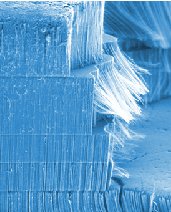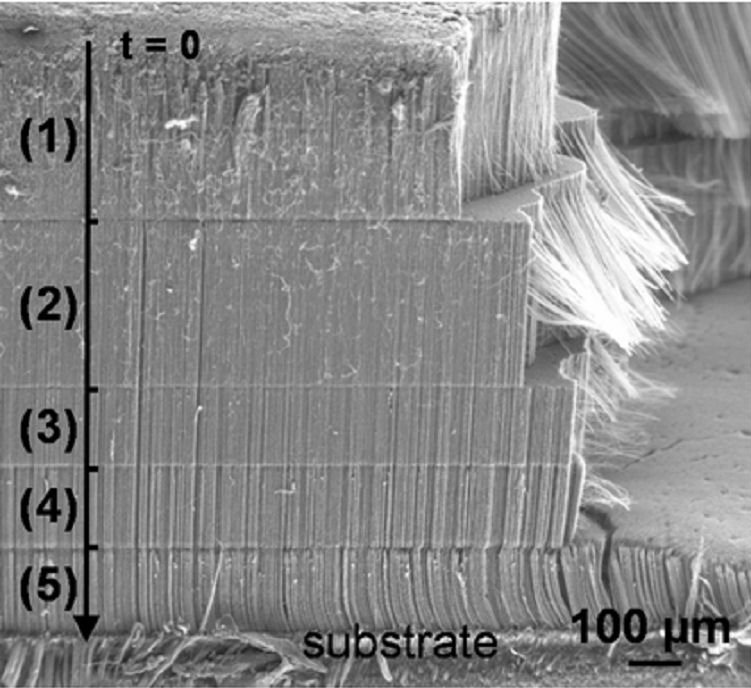M. Pinault1, M. Mayne-L’Hermite1, C. Reynaud
1CEA Saclay – DSM/DRECAM/Service des Photons, Atomes et Molécules – Laboratoire Francis Perrin
2CEA Saclay – DSM/DRECAM/Laboratoire Pierre Sue
3Laboratoire de Physique des Solides, CNRS UMR 8502, Univ. Paris Sud, 91405 Orsay

Since their discovery by Ijima in 1991, carbon nanotubes are always also attractive by their structure and their resulting remarkable properties. Their mechanism of growth itself does not cease intriguing the scientific community. Generally their formation takes place on a substrate by reaction between a carbonaceous molecule and a catalytic nanoparticule (Iron, Nickel, or Cobalt) at an adequate temperature. Base-growth, i.e. the nanotube grows up above the particle that remains on the substrate, as well as top-growth where the particle remains in top of the growing nanotube are observed. But very little direct experimental evidences exist about the advance of carbon during these processes.
A method of synthesis using a toluene and ferrocene aerosol which reacts on the hot substrate has been developed in Saclay. Clean and perfectly aligned carpets of multi-wall carbon nanotubes are obtained. The growth rate is important, and the thickness of the carpet may reach up to a few millimeters. The study of the earliest growth instants reveals the initial formation of catalytic nanoparticles on the substrate, followed by the growth of the nanotubes “from the base”. However, some questions remain: how the growth can continue “from the base” when a carpet of several millimeters is formed ? What is the path of the carbon atoms?
To better understand how the growth continues, the team had the idea to make successive syntheses, by stopping the process and continuing it under identical or modified conditions. This allowed pointing out a remarkable phenomenon: the growth always starts again from the substrate by raising if necessary the previously grown carpets of nanotubes. This is illustrated by the left-hand picture where successive growths with decreasing durations were performed. The height of the carpet being proportional to the duration of the sequence, it is easy to attribute the top layer to the first synthesis and the bottom one to the very last.
Thus, that proves that the precursors diffuse through all the height of the pre-existent carpet to react only on the substrate. Moreover, this reaction takes place only if the metal precursor is present. In its absence, only a fine layer of amorphous carbon is formed, under which the nanotubes grow again as soon as the metal precursor is reintroduced. It is even possible to grow a new carpet under another which was left and the sample stored outside the engine.

Lastly, the sequential use of two solutions, the second being 13C enriched, shows definitively that the carbon atoms diffuse well through all the preexistent carpet of nanotubes or in growth and are introduced only into nanotubes in contact with the catalytic particle on the substrate. This result was obtained by carrying out a cartography of the samples (see the the right-hand image) by means of the nuclear micro-probe of Saclay. Thus, the mechanisms governing the growth of the nanotube layers are well-identified together with the process to form controlled multi-layer of aligned carbon nanotubes that opens the way to multiple applications.
Thus, not only the mechanisms governing the growth of aligned nanotubes were greatly clarified, but we have now the way to control the growth of multilayers of aligned carbon nanotubes, opening the way to multiple applications.
14-11-2005

References :
[1] “Growth of multiwalled carbon nanotubes during the initial stages of aerosol-assisted CCVD” M. Pinault, M. Mayne-L’Hermite, C. Reynaud, V. Pichot, P. Launois and D. Ballutaud, Carbon 43, 2968, (2005)
[2] “Evidence of sequential lift in growth of aligned multi-walled carbon nanotube multilayers” M. Pinault, V. Pichot, H. Khodja, P. Launois, C. Reynaud and M. Mayne-L’Hermite, Nano Lett. 5 (12), 2394, (2005).

